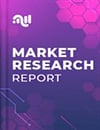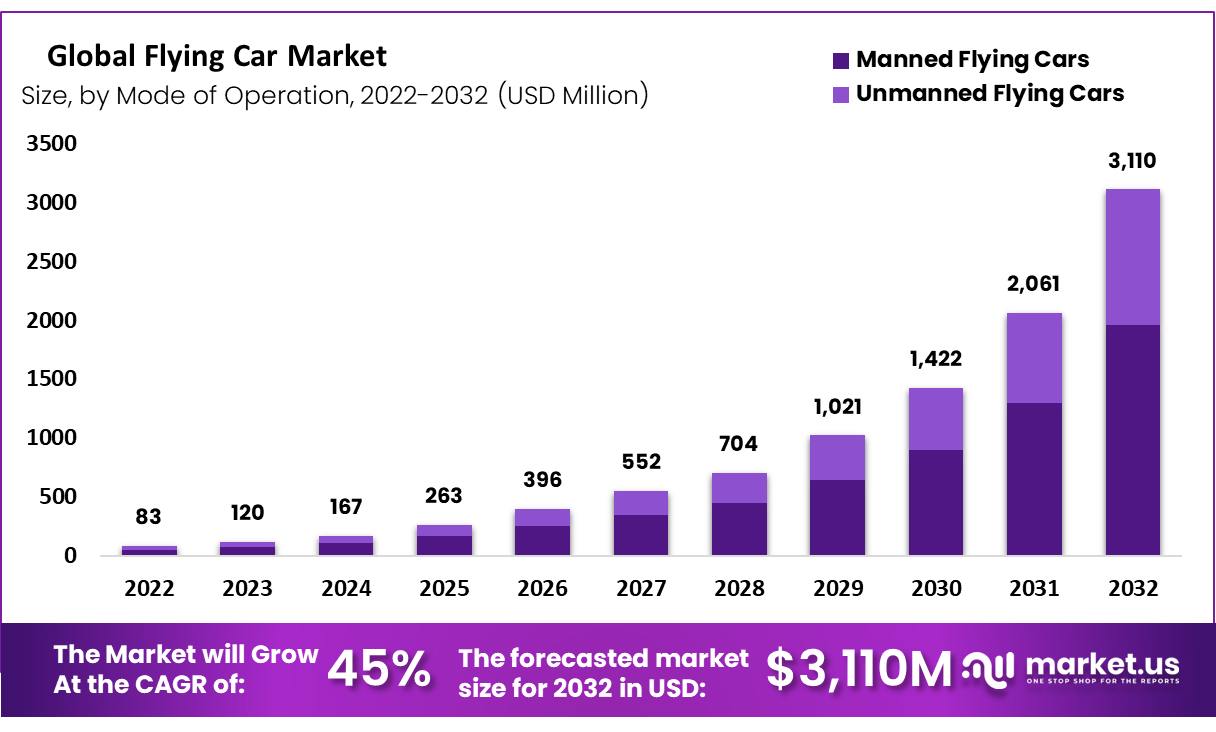Global Flying Car Market By Mode of Operation (Manned Flying Cars and Unmanned Flying Cars), By Application (Military, Commercial, and Civil), By Seating Capacity (One, Two, Four, and More Than Four), By Region and Companies - Industry Segment Outlook, Market Assessment, Competition Scenario, Trends, and Forecast 2023-2032
- Published date: Oct 2023
- Report ID: 101885
- Number of Pages: 234
- Format:
- keyboard_arrow_up
Quick Navigation
Report Overview
The Global Flying Car Market size is expected to be worth around USD 3,110 Million by 2032, From USD 120 Million by 2023, with growth at a CAGR of 45% during the forecast period from 2023 to 2032.
Flying can also be referred to as a personal air vehicle, a dual-mode vehicle, or a dual-mode vehicle. It can be traveled by both air and by road route. The flying cars possess two propellers as well as protective devices. Aerial cars are an advanced version of cars developed to overcome the problems faced by people in heavy traffic areas.
The factors that were responsible for the growth of the global flying cars market during the forecast period are increasing demand for environment-friendly automobiles, increasing concern over the safety of vehicles and drivers, increasing demographic rate, and growth in urbanization. Furthermore, the improvement in the standard of living and increase in the disposable income of people will likely surge the market growth. Also, the need for more efficient and better transportation was estimated to increase the demand for flying cars during the forecast period.

Driving Factors
Increase in the Traffic Problem
The increase in transportation, specifically by road and train, results in heavy traffic, mostly in urban areas. Additionally, water transportation is mostly used for long-distance cargo transport because of its cheaper costs. However, it has a limitation in that it is not feasible in most of the urban areas. Furthermore, the air transportation system is mostly used for international transportation.
But it is way too costly. Hence, for the urban environment, the ground, underground, and NGS transportation solutions are suitable. Therefore, during the forecast period, the advancements in cars are estimated to gain enormous attention from the urban population and will likely increase the demand in the market.
Restraining Factors
Safety Issues and High Manufacturing Costs
One of the major factors that hinder the growth of the market is the manufacturing cost of aerial vehicles because these cars consist of costly alloys, the latest high-tech composites, and advanced battery technology. All these factors increase the manufacturing costs of the cars.
Growth Opportunities
Increasing Contracts and Agreements for Long-term Business Opportunities
The business executives, the ultra-rich population, and the commercial service providers are estimated to increase the demand for flying cars due to the variations in urban commute requirements and the rise in traffic congestion situations. Furthermore, in the early phase, flying cars are made-to-order product lines, and it is mostly built in fewer units along with the signed agreements and contracts between developers and end users of flying cars.
Thus, these agreements and contracts are allied with long-standing business opportunities with end-users. Additionally, to gain a competitive advantage in the global flying car market, the participants in the market need to concentrate on acquiring agreements and contracts.
Latest Trends
Implementation of Advanced Technologies
The lifestyle of the people was changing and shifting towards innovative technologies. Additionally, the demand for long-distance traveling by consuming less time is surging across the world. Furthermore, with the rising popularity of unmanned aerial vehicles and the regulation that supports their commercial use, the aerial car was likely to become a reality along with the development of aircraft and aerospace design technology.
By Mode of Operation Analysis
Unmanned Flying Cars Segment Dominated the Global Flying Car Market
The mode of operation segment was divided into manned flying cars and unmanned flying cars. The unmanned flying cars segment dominated the market with the highest revenue share of 63% owing to the rising demand for environment-friendly unmanned aerial vehicles, the increasing necessity to resolve the road congestion problem, and rapid technological advancement.
Also, they don’t need any human assistance to fly because they are automatic. This will result in cheaper operating costs. At the same time, manned flying cars need a pilot to operate. It was intended to fly at medium to long distances by carrying people.
By Application Analysis
Military Segment Accounted for the Majority of Share
The application segment was divided into military, commercial, and civil. The military segment held the majority share of 48% of the market. For instance, the U.S. Air Force was developing the aircraft by performing multiple tests, and this will help to determine the use of the aircraft for several applications.
By Seating Capacity Analysis
The Seating Capacity of Two People will likely hold the Largest Market Share
The seating capacity is segmented into one, two, four, and more than four. The seating capacity of two people will likely hold the largest market share owing to the increasing demand for better performance and fuel economy. Also, the dominance of the segment was estimated to continue during the forecast period. The benefits of the two-sitter flying car are quick networking and high-speed data transfer between adjacent servers with the help of advanced AI and blockchain technology.

Key Market Segments
By Mode of Operation
- Manned Flying Cars
- Unmanned Flying Cars
By Application
- Military
- Commercial
- Civil
By Seating Capacity
- One
- Two
- Four
- More Than Four
COVID-19 Impact Analysis
The COVID-19 Pandemic had a negative impact on the Global Flying Car Market
The COVID-19 pandemic has disrupted most industries, including the automotive and transportation industries. During the pandemic, the changes in customers purchasing behavior and preferences have had an impact on the global market.
Moreover, in various regions across the world, regulatory authorities have declared different regulatory measures and restricted cross-border commerce. Also, the pandemic has diminished car usage to encourage people to follow social distancing. Additionally, because of the ban on traveling in the majority of countries, the global flying car market was hindered during the pandemic.
Regional Analysis
North America Dominated the Global Flying Car Market
North America dominated the market by collecting the largest share of 38% of the overall market owing to factors such as increasing demand for sustainable electric vehicles in public & commercial vehicle sectors and an increasing number of flying car projects. Additionally, Canada and Mexico are the chief producers of flying car components, while North America and Europe are the chief buyers. Also, huge investments in safety sensors and advanced battery technology will enhance the growth of the market.

Key Regions
- North America
- The US
- Canada
- Mexico
- Western Europe
- Germany
- France
- The UK
- Spain
- Italy
- Portugal
- Ireland
- Austria
- Switzerland
- Benelux
- Nordic
- Rest of Western Europe
- Eastern Europe
- Russia
- Poland
- The Czech Republic
- Greece
- Rest of Eastern Europe
- APAC
- China
- Japan
- South Korea
- India
- Australia & New Zealand
- Indonesia
- Malaysia
- Philippines
- Singapore
- Thailand
- Vietnam
- Rest of APAC
- Latin America
- Brazil
- Colombia
- Chile
- Argentina
- Costa Rica
- Rest of Latin America
- Middle East & Africa
- Algeria
- Egypt
- Israel
- Kuwait
- Nigeria
- Saudi Arabia
- South Africa
- Turkey
- United Arab Emirates
- Rest of MEA
Archer and Fiat Chrysler United to Decrease the Purchase Costs
Numerous prominent players are concentrating on the engineering and development of aerial cars to provide better facilities to people. For instance, Archer and Fiat Chrysler have partnered with the aim of reducing the purchase cost. Additionally, this partnership has boosted the introduction of flying cars. It was intended to carry passengers by making minimal noise.
Top Key Players
- Airbus
- AeroMobil
- Boeing Co
- EHang
- Lilium GmbH
- Volocopter GmbH
- Terrafugia
- PAL-V International B.V.
- Joby Aviation
- Other Key Players
Recent Developments:
- In October 2022– Volocopter effectively directed the first eVTOL with the passenger’s onboard test flights, and this test is the breakthrough towards the launch of advanced air mobility services in Rome by 2024.
- In March 2022– Aeromobi introduced AM NEXT. It is the first 4-seater flying car in the world. Also, Aeromobi has publicized that AM NEXT is a fleet aerial ride-hailing service that will be introduced in 2027. Furthermore, it will also deliver offer a range of 100-150 miles.
Report Scope:
Report Features Description Market Value (2022) US$ 83 Mn Forecast Revenue (2032) US$ 3,110 Mn CAGR (2023-2032) 45% Base Year for Estimation 2022 Historic Period 2016-2022 Forecast Period 2023-2032 Report Coverage Revenue Forecast, Market Dynamics, COVID-19 Impact, Competitive Landscape, Recent Developments Segments Covered By Mode of Operation- Manned Flying Cars and Unmanned Flying Cars); By Application- Military, Commercial, and Civil; and By Seating Capacity- One, Two, Four, and More Than Four. Regional Analysis North America – The US, Canada, & Mexico; Western Europe – Germany, France, The UK, Spain, Italy, Portugal, Ireland, Austria, Switzerland, Benelux, Nordic, and rest of Western Europe; Eastern Europe – Russia, Poland, The Czech Republic, Greece, & Rest of Eastern Europe; APAC – China, Japan, South Korea, India, Australia & New Zealand, Indonesia, Malaysia, Philippines, Singapore, Thailand, Vietnam, & Rest of APAC; Latin America – Brazil, Colombia, Chile, Argentina, Costa Rica, & Rest of Latin America; The Middle East & Africa – Algeria, Egypt, Israel, Kuwait, Nigeria, Saudi Arabia, South Africa, Turkey, United Arab Emirates, & Rest of MEA. Competitive Landscape Airbus, AeroMobil, Boeing Co, EHang, Lilium GmbH, Volocopter GmbH, Terrafugia, PAL-V International B.V., Joby Aviation, and Other Key Players. Customization Scope Customization for segments, region/country-level will be provided. Moreover, additional customization can be done based on the requirements. Purchase Options We have three licenses to opt for Single User License, Multi-User License (Up to 5 Users), Corporate Use License (Unlimited User and Printable PDF) Frequently Asked Questions (FAQ)
Which companies are making the flying cars Market?Airbus, AeroMobil, Boeing Co, EHang, Lilium GmbH, Volocopter GmbH, Terrafugia, PAL-V International B.V., Joby Aviation, Other Key Players.
How big is the flying car market?The global Flying Car market size is expected to be worth around USD 83 Million by 2022 from USD 3,110 Million in 2032
What will be the CAGR of global flying car market?The global flying car market is poised to grow at a CAGR of 45%.from 2023 to 2032.

- Airbus
- AeroMobil
- The Boeing Company Company Profile
- EHang
- Lilium GmbH
- Volocopter GmbH
- Terrafugia
- PAL-V International B.V.
- Joby Aviation
- Other Key Players
- settingsSettings
Our Clients
| Single User $4,599 $3,499 USD / per unit save 24% | Multi User $5,999 $4,299 USD / per unit save 28% | Corporate User $7,299 $4,999 USD / per unit save 32% | |
|---|---|---|---|
| e-Access | |||
| Report Library Access | |||
| Data Set (Excel) | |||
| Company Profile Library Access | |||
| Interactive Dashboard | |||
| Free Custumization | No | up to 10 hrs work | up to 30 hrs work |
| Accessibility | 1 User | 2-5 User | Unlimited |
| Analyst Support | up to 20 hrs | up to 40 hrs | up to 50 hrs |
| Benefit | Up to 20% off on next purchase | Up to 25% off on next purchase | Up to 30% off on next purchase |
| Buy Now ($ 3,499) | Buy Now ($ 4,299) | Buy Now ($ 4,999) |












